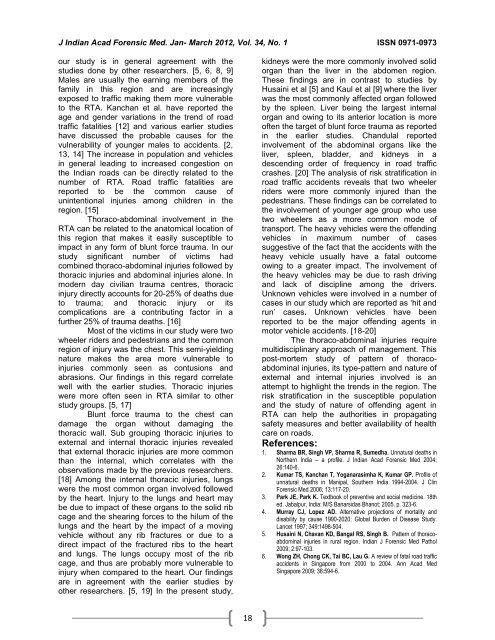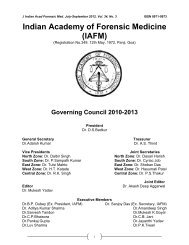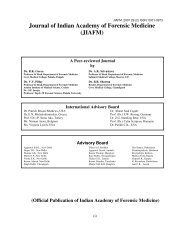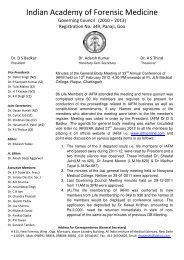Indian Academy of Forensic Medicine (IAFM) - Official website of IAFM
Indian Academy of Forensic Medicine (IAFM) - Official website of IAFM
Indian Academy of Forensic Medicine (IAFM) - Official website of IAFM
You also want an ePaper? Increase the reach of your titles
YUMPU automatically turns print PDFs into web optimized ePapers that Google loves.
J <strong>Indian</strong> Acad <strong>Forensic</strong> Med. Jan- March 2012, Vol. 34, No. 1 ISSN 0971-0973<br />
our study is in general agreement with the<br />
studies done by other researchers. [5, 6, 8, 9]<br />
Males are usually the earning members <strong>of</strong> the<br />
family in this region and are increasingly<br />
exposed to traffic making them more vulnerable<br />
to the RTA. Kanchan et al. have reported the<br />
age and gender variations in the trend <strong>of</strong> road<br />
traffic fatalities [12] and various earlier studies<br />
have discussed the probable causes for the<br />
vulnerability <strong>of</strong> younger males to accidents. [2,<br />
13, 14] The increase in population and vehicles<br />
in general leading to increased congestion on<br />
the <strong>Indian</strong> roads can be directly related to the<br />
number <strong>of</strong> RTA. Road traffic fatalities are<br />
reported to be the common cause <strong>of</strong><br />
unintentional injuries among children in the<br />
region. [15]<br />
Thoraco-abdominal involvement in the<br />
RTA can be related to the anatomical location <strong>of</strong><br />
this region that makes it easily susceptible to<br />
impact in any form <strong>of</strong> blunt force trauma. In our<br />
study significant number <strong>of</strong> victims had<br />
combined thoraco-abdominal injuries followed by<br />
thoracic injuries and abdominal injuries alone. In<br />
modern day civilian trauma centres, thoracic<br />
injury directly accounts for 20-25% <strong>of</strong> deaths due<br />
to trauma; and thoracic injury or its<br />
complications are a contributing factor in a<br />
further 25% <strong>of</strong> trauma deaths. [16]<br />
Most <strong>of</strong> the victims in our study were two<br />
wheeler riders and pedestrians and the common<br />
region <strong>of</strong> injury was the chest. This semi-yielding<br />
nature makes the area more vulnerable to<br />
injuries commonly seen as contusions and<br />
abrasions. Our findings in this regard correlate<br />
well with the earlier studies. Thoracic injuries<br />
were more <strong>of</strong>ten seen in RTA similar to other<br />
study groups. [5, 17]<br />
Blunt force trauma to the chest can<br />
damage the organ without damaging the<br />
thoracic wall. Sub grouping thoracic injuries to<br />
external and internal thoracic injuries revealed<br />
that external thoracic injuries are more common<br />
than the internal, which correlates with the<br />
observations made by the previous researchers.<br />
[18] Among the internal thoracic injuries, lungs<br />
were the most common organ involved followed<br />
by the heart. Injury to the lungs and heart may<br />
be due to impact <strong>of</strong> these organs to the solid rib<br />
cage and the shearing forces to the hilum <strong>of</strong> the<br />
lungs and the heart by the impact <strong>of</strong> a moving<br />
vehicle without any rib fractures or due to a<br />
direct impact <strong>of</strong> the fractured ribs to the heart<br />
and lungs. The lungs occupy most <strong>of</strong> the rib<br />
cage, and thus are probably more vulnerable to<br />
injury when compared to the heart. Our findings<br />
are in agreement with the earlier studies by<br />
other researchers. [5, 19] In the present study,<br />
18<br />
kidneys were the more commonly involved solid<br />
organ than the liver in the abdomen region.<br />
These findings are in contrast to studies by<br />
Husaini et al [5] and Kaul et al [9] where the liver<br />
was the most commonly affected organ followed<br />
by the spleen. Liver being the largest internal<br />
organ and owing to its anterior location is more<br />
<strong>of</strong>ten the target <strong>of</strong> blunt force trauma as reported<br />
in the earlier studies. Chandulal reported<br />
involvement <strong>of</strong> the abdominal organs like the<br />
liver, spleen, bladder, and kidneys in a<br />
descending order <strong>of</strong> frequency in road traffic<br />
crashes. [20] The analysis <strong>of</strong> risk stratification in<br />
road traffic accidents reveals that two wheeler<br />
riders were more commonly injured than the<br />
pedestrians. These findings can be correlated to<br />
the involvement <strong>of</strong> younger age group who use<br />
two wheelers as a more common mode <strong>of</strong><br />
transport. The heavy vehicles were the <strong>of</strong>fending<br />
vehicles in maximum number <strong>of</strong> cases<br />
suggestive <strong>of</strong> the fact that the accidents with the<br />
heavy vehicle usually have a fatal outcome<br />
owing to a greater impact. The involvement <strong>of</strong><br />
the heavy vehicles may be due to rash driving<br />
and lack <strong>of</strong> discipline among the drivers.<br />
Unknown vehicles were involved in a number <strong>of</strong><br />
cases in our study which are reported as ‘hit and<br />
run’ cases. Unknown vehicles have been<br />
reported to be the major <strong>of</strong>fending agents in<br />
motor vehicle accidents. [18-20]<br />
The thoraco-abdominal injuries require<br />
multidisciplinary approach <strong>of</strong> management. This<br />
post-mortem study <strong>of</strong> pattern <strong>of</strong> thoracoabdominal<br />
injuries, its type-pattern and nature <strong>of</strong><br />
external and internal injuries involved is an<br />
attempt to highlight the trends in the region. The<br />
risk stratification in the susceptible population<br />
and the study <strong>of</strong> nature <strong>of</strong> <strong>of</strong>fending agent in<br />
RTA can help the authorities in propagating<br />
safety measures and better availability <strong>of</strong> health<br />
care on roads.<br />
References:<br />
1. Sharma BR, Singh VP, Sharma R, Sumedha. Unnatural deaths in<br />
Northern India – a pr<strong>of</strong>ile. J <strong>Indian</strong> Acad <strong>Forensic</strong> Med 2004;<br />
26:140-6.<br />
2. Kumar TS, Kanchan T, Yoganarasimha K, Kumar GP. Pr<strong>of</strong>ile <strong>of</strong><br />
unnatural deaths in Manipal, Southern India 1994-2004. J Clin<br />
<strong>Forensic</strong> Med 2006; 13:117-20.<br />
3. Park JE, Park K. Textbook <strong>of</strong> preventive and social medicine. 18th<br />
ed. Jabalpur, India: M/S Banarsidas Bhanot; 2005. p. 323-6.<br />
4. Murray CJ, Lopez AD. Alternative projections <strong>of</strong> mortality and<br />
disability by cause 1990-2020: Global Burden <strong>of</strong> Disease Study.<br />
Lancet 1997; 349:1498-504.<br />
5. Husaini N, Chavan KD, Bangal RS, Singh B. Pattern <strong>of</strong> thoracoabdominal<br />
injuries in rural region. <strong>Indian</strong> J <strong>Forensic</strong> Med Pathol<br />
2009; 2:97-103.<br />
6. Wong ZH, Chong CK, Tai BC, Lau G. A review <strong>of</strong> fatal road traffic<br />
accidents in Singapore from 2000 to 2004. Ann Acad Med<br />
Singapore 2009; 38:594-6.









